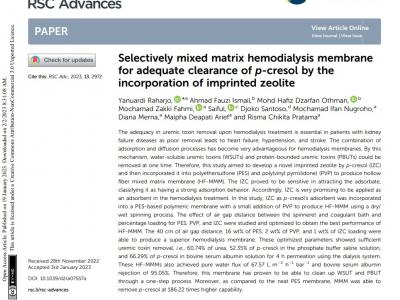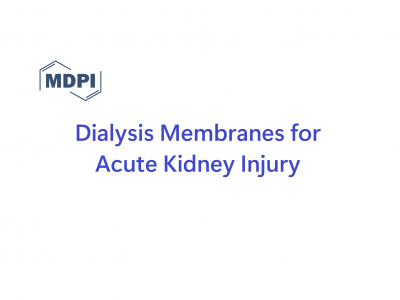
Artikel
- Sort by :
- Subcategory /
- Date

Selectively mixed matrix hemodialysis membrane for adequate clearance of p-cresol by the incorporation of imprinted zeolite
- Artikel Ilmiah
- /
- 02/02/2023
Abstract The adequacy in uremic toxin removal upon hemodialysis treatment is essential in patients with kidney failure diseases as poor removal leads to heart failure, hypertension, and stroke. The combination of adsorption and diffusion processes has become very advantageous for hemodialysis membranes. By this mechanism, water-soluble uremic toxins (WSUTs) and protein-bounded uremic toxins (PBUTs) could be removed at one time. Therefore, this study aimed to develop a novel imprinted zeolite by p-cresol (IZC) and then incorporated it into polyethersulfone (PES) and poly(vinyl pyrrolidone) (PVP) to produce hollow fiber mixed matrix membrane (HF-MMM). The IZC proved to be sensitive in attracting the adsorbate, classifying it as having a strong adsorption behavior.

Asymptomatic COVID-19 Patient with a Subtle Hypercoagulable State and Fluctuating D-dimer Level
- Artikel Ilmiah
- /
- 23/04/2022
Abstract Background: COVID-19 can infect an asymptomatic person silently without any overt symptoms despite diffuse blood clots throughout the body. Clot formation is induced by COVID-19 associated coagulopathy that can cause a high mortality rate. D-dimer, a fairly decisive marker for the coagulopathy event, is physiologically a marker of the fibrinolysis process. The increase of D-dimers in COVID-19 cases must be followed up because it relates to the initiation of a cytokine storm. Case presentation: We report an asymptomatic patient with sudden D-dimer elevation who received anticoagulant therapy. After three days of heparin administration, D-dimer results became normal and anticoagulant therapy was stopped. However, on the 12th day, the D-dimer level rebounded back and was followed by an increase of hs-C-reactive protein, erythrocyte sedimentation rate, IL-6, although SARS-CoV-2 PCR result became negative. A hyperglycaemic reaction and a sudden increase of HbA1C was observed in the patient. After three weeks D-dimer had returned to normal levels, and so did the other markers. The patient recovered fully and still no symptoms were obvious.

Antimicrobial activities of fungus comb extracts isolated from Indomalayan termite (Macrotermes gilvus Hagen) mound
- Artikel Ilmiah
- /
- 22/03/2022
Abstract Incorporating antimicrobial components into food packaging materials can prevent microbial contamination. Fungus combs could be an alternative source of natural antimicrobial agents. In this study, n-hexane, ethyl acetate, methanol, and water extracts were obtained from fungus combs isolated from Indomalayan termite (Macrotermes gilvus Hagen) mound. Their antibacterial and antifungal activities against food spoilage microorganisms including Escherichia coli ATCC 25922, Pseudomonas aeruginosa ATCC 27853, Staphylococcus aureus ATCC 25923, Aspergillus flavus, and Aspergillus niger were evaluated by Kirby–Bauer disc diffusion and microdilution. Results showed that ethyl acetate extract formed the largest diameter inhibition zone for all tested bacteria and fungi, exhibited antibacterial activity against all tested bacteria with minimum inhibitory concentration (MIC) and minimum bactericidal concentration (MBC) values of 0.39 and 0.78 mg/mL, respectively, and suppressed A. flavus and A. niger with an MIC value of 0.78 mg/mL.

Dialysis Membranes for Acute Kidney Injury
- Artikel Ilmiah
- /
- 15/03/2022
Abstract Mortality and morbidity rates among critically ill septic patients having acute kidney injury (AKI) are very high, considering the total number of deaths after their admission. Inappropriate selection of the type of continuous renal replacement therapy and inadequate therapy become the immediate causes of these issues. Dialysis is a commonly used treatment intended to prolong the life of AKI patients. Dialysis membranes, which are the core of dialysis treatment, must be properly selected to ensure fair treatment to the patients. The accumulation of certain types of molecules must be dealt with using the right membrane. Whether it is low-flux, high-flux, or adsorptive type, the dialysis membrane should be chosen depending on the condition of the patients. The selection of dialysis membranes should also be based on their effect on the treatment outcomes and well-being. All these options are needed to serve the patients of different clinical settings.

Infrapatellar Fat Pad-Derived Mesenchymal Stem Cells as an Alternative Cell Source for Cell-based Osteoarthritis Treatment
- Artikel Ilmiah
- /
- 11/03/2022
A Systematic Review on Preclinical and Clinical Evidence ABSTRACT Introduction: There is still no definitive treatment to either inhibit the degradation process or restore the damaged cartilage in osteoarthritis (OA). Various cell sources have been studied and in vitro studies showed that infrapatellar fat pad-derived mesenchymal stem cells (IFPDMSCs) exhibit higher chondrogenic potential than other adipose-derived cells. Still, very few in vivo studies on IFPDMSCs for cartilage healing in OA have been reported. Aims: This systematic review will analyze the therapeutic potential of IFPDMSCs for cartilage healing in osteoarthritis from preclinical and clinical studies. Design, Methods, and Data Source: Using the PubMed, EMBASE, and Cochrane Library database up to November 30, 2020, a systematic review according to PRISMA reporting guideline was conducted on IFPDMSCs application to treat osteoarthritis in vivo studies. Inclusion criteria were in vivo preclinical and clinical studies from January 2010 to November 2020 involving the OA model or cases using IFPDMSCs to promote healing.